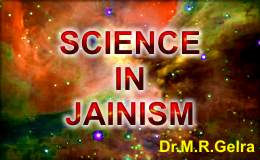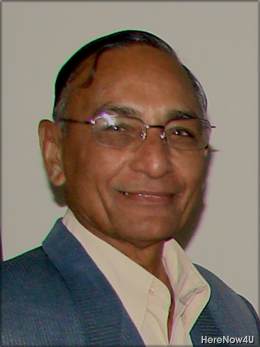
Einstein's Theory of Relativity and Heisenberg's Theory of Uncertainty are in tune with the Jain doctrine of Anekant. A particular mode appears only in a particular set of conditions with changed conditions there will be another mode of existence of that thing. So all our knowledge of a thing at particular spatio-temporal locus is conditional and relative to the circumstances. Of course, the possibility of absolute knowledge is all the while there. This is known as Nayavad.
In the beginning of the nineteenth century, French Scientist Laplace established the doctrine of scientific determinism on the lines of Newton Laws and argued that there should be a set of scientific laws that would predict everything that is happening in the universe including the human behaviour, if only we know the complete state of the universe at one time.
The advent of Law of Uncertainty in 1926 by Heisenberg, it signalled an end to Laplace's dream that the Universe could be completely deterministic, because one cannot measure the present state of the universe precisely! To measure the present state of position and velocity of a particle accurately, the obvious way is to shine light on the particle. The use of quantum light in any observation disturbs the particle and changes its velocity in a way that cannot be predicted. Moreover the more accurately one measures the position of the particle, the less accurately one can measures velocity and vice-versa. Stephen Hawking has pointed out that Uncertainty Principle is a fundamental, inescapable property of the world.
Anekant argues that the rational knowledge that occurs at the sensory level always requires some medium i.e. carrier of waves or energy. For example, if some object is to be seen by an eye, a ray of light i.e. quantum of energy is required. Other senses of the body also require the support of some waves for cognition of an object. It seems, therefore, that the cognition at the sensory level disturbs the position and condition of the object i.e. the object changes its paryaya. Hence it is correct to say that the same object does not exist in its present state when cognition occurs, because nobody can observe the present state of the universe without disturbing it. This uncertainty of cognition leads to Unpredictability. The Jains have, therefore, termed the sensory knowledge as indirect knowledge. The indirect knowledge can be transmitted through a system of Saptabhangi, which deals with Existence, Non-existence and unpredictability. While describing an event, the theory of saptabhangi refers to terms of not only substance (dravya) but also refers to area (kshetra), time (kala) and attribute (bhavya).
The quantum mechanics has gone a step further to suggest that the uncertainty in the position and velocity of a particle should be viewed as a combination of both, that is to say that quantum mechanics does not predict a single definite result for an observation. Instead, it predicts a number of different possible outcomes and introduces a probability factor. Quantum Mechanics has given similar treatment in case of the duality of waves and particles. Where there is dual nature, randomness or unpredictability occurs. The unpredictable, random element comes in only when we try to interpret the wave in terms of the positions and velocities of particles. This description of unpredictability in the field of physical science is very helpful in understanding the 'avaktaya' of saptabhangi.The Jains have adopted two-tier system of knowledge.
- Sensory i.e. indirect knowledge
- Intuition i.e. direct or super sensory knowledge.
In case of direct knowledge, no carrier of energy is required for cognition. So the cognition occurs without disturbing the present state of the object. Such knowledge is pure and absolute. Whereas, in case of sensory knowledge, the use of carrier energy is required which disturbs the position of the object, hence it is known as indirect knowledge.
Besides Anekantvad, Nayavad and Syadvad, the general method of approaching a subject is further systematized in the form of the four Anuyogdvars, the tribhanga, the chaturbhang and the nikesap (name, sthapana, dravya and bhava). It is of special interest that these various methodologies sometimes have nothing to do with the text to be explained but the inclusion of which in the teaching programme seemed essential or desirable to make the instruction richer and more rewarding for teachers and pupils. It is therefore said that the Jain Acharyas were the best teachers; they could apply various methods and techniques in explaining the contents of the scriptures to the pupils.
These methods have helped in understanding the difficult and imperfectly explored texts with their old commentaries, the churnis and the Niryuktis. Prof. ALSDORF has said 'there is no exaggeration if it is said that most of the original Jain contributions to Indian scholarship were made in the field of methodology'. Dr. A.N. Upadhyaya said 'the approach to reality adopted by Anekantvad strikes an original note in the history of Indian logic'. At the same time except the Anekant and Syadvad, the rest of the methodologies apparently reached their possible limits of its development and gradually fell into disuse.
The beginning of the Jain Philosophy can be traced to its oldest canonical text the Acharang Agam. From the very first sentences of the Acharang, it is clear that the migration of soul is accepted and it is mentioned that one who accepts this migration of soul is Atmavadi, Lokvadi, Karmavadi and Kriyavadi. It shows that Jain philosophy starts with its fundamental principle of soul and its transmigration in space (Loka) due to the activity (kriya) of karma. The ultimate goal of Jainism is to liberate the soul from karmic bondage.
Jain philosophy proposes the theory of kriyavad, making it clear that Jains are not Nastikvadi. Jain philosophy according to the Acharang Sutra, conceives two real entities in this Loka (universe), the living beings (soul or chitta) and the matter (non soul or achitta). These two entities do not transform mutually though they exist together in the universe. The limitation of this concept is that the soul and karrna coexist from the very beginning of time in this universe (loka) and the spiritual soul and material karma are eternal.
It is interesting to correlate this limitation of the Jain concept about universe and time with the modern theoretical physics. We are reminded of "Einstein's famous question about whether God had any choice in creating the universe?" The renowned physicist's Hawking speaks of ‘A universe with no edge in space, no beginning or end in time, and nothing for a creator to do.’
A saint philosopher of the twenty-first century Acharya Mahapragya has observed the duality of apparently contrary attributes in substance and found that they enjoy mutual concomitance. Some of them are as follows:
- Universal and particular
- Permanent and impermanent
- Existence and non-existence
- Speakable and unspeakable
- Being and non-being
 Dr. Mahavir Raj Gelra
Dr. Mahavir Raj Gelra

